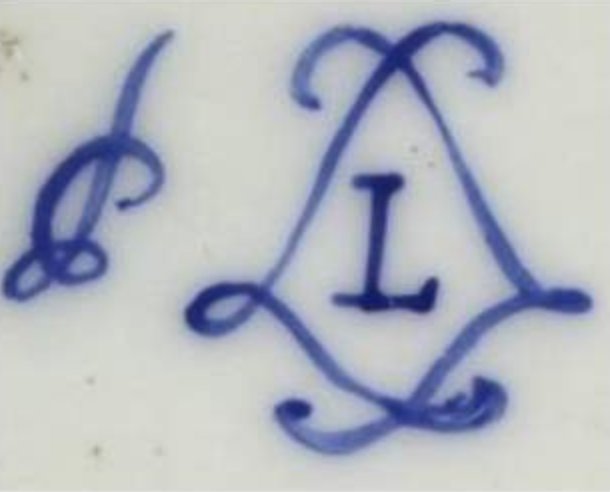The First Ground Color
Bleu en Lapis is a dark color, close in tonality to navy blue with a hint of violet. This ground color, which remained popular throughout the eighteenth-century, interestingly had a predessesor in the earlier days of the porcelain manufactory when it resided at the Vincennes Chateau. The earliest instances of this color are cited in Vincennes inventories as “en bleu lapis” and/or, “M. Helot’s bleu.”

This image is meant to act as a visual guide for viewers to see a set of Sèvres plates together in a dining setting that is historically accurate in regards to eighteenth-century customs. This table setting displays twelve bleu en lapis plates atop a white damask table cloth in partnership with silver eighteenth-century cutlery, with a centerpiece of two Vincennes porcelain flower arrangements flanking a blue de roi Sèvres serving platter.
Vincennes was established as a private holding in 1740 by Louis Orry de Fulvey and his half-brother. Orry de Fulvey had been the director of the East India Company in France and was therefore, by 1740, extremely well acquainted with the luxury material as he had been involved with the importation of East Asian porcelain through his position.[i] He was a man with a knack for investment and, along with his half-brother who was the finance minister to the King, he established the Vincennes porcelain factory in 1740. With a power grounded in financial stability Orry de Fulvey was able to lure three key figures from a rival French porcelain factory at Chantilly to come invent porcelain at his new establishment. The three figures include Claude-Humbert Gérin and the Dubois brothers. Gérin, it is thought, is the individual who had the knowledge and skills to conceive the soft-paste porcelain medium at Vincennes and it is known—thanks to archival records—that the Dubois brothers had worked at Chantilly in the capacity of modeler and thrower respectively.[ii]
There are no surviving pieces of Vincennes porcelain within the first few years but archival records show salaries being awarded beginning in 1741. Scholar, John Whitehead, affirms on this note that “they must surely have been producing something.”[iii] Moving ahead a couple of years, in 1745, the Vincennes artisans and management were confident enough in their products that they requested a monopoly to be granted in their name for the production of porcelain wares in France. The year 1745 also saw a financial change; shares in the factory were sold to court members, the French monarchy, and other interested affluent individuals. It is during this same year, that the factory “began calling itself a manufacture royale” and denoting its privilege on the bottom of each ware with the monarchical mark of interlaced “Ls”.[iv] Thus while it is important to note that Vincennes/Sèvres porcelain began as a privately owned and funded establishment, it did not remain as such for long. Louis Orry de Fulvy stayed involved with the institution until his death in 1759 (which was the same year King Louis XV assumed sole ownership). With royal backing, both socially and financially, Vincennes was able to bring in the best artisans, chemists, and creatives to contribute to their mission.
In a forward to a recent text on the history of Sèvres, David Caméo, the current general director at the Sèvres manufactory, beautifully articulated that in “1740—Vincennes. A small and fragile porcelain factory is born. Its one remarkable secret: a porcelain paste of exceptional whiteness and beauty.”[iv] He goes on to say that Vincennes “stood every chance of success” thanks to “the dynamic context of the Age of Enlightenment.” [v]


